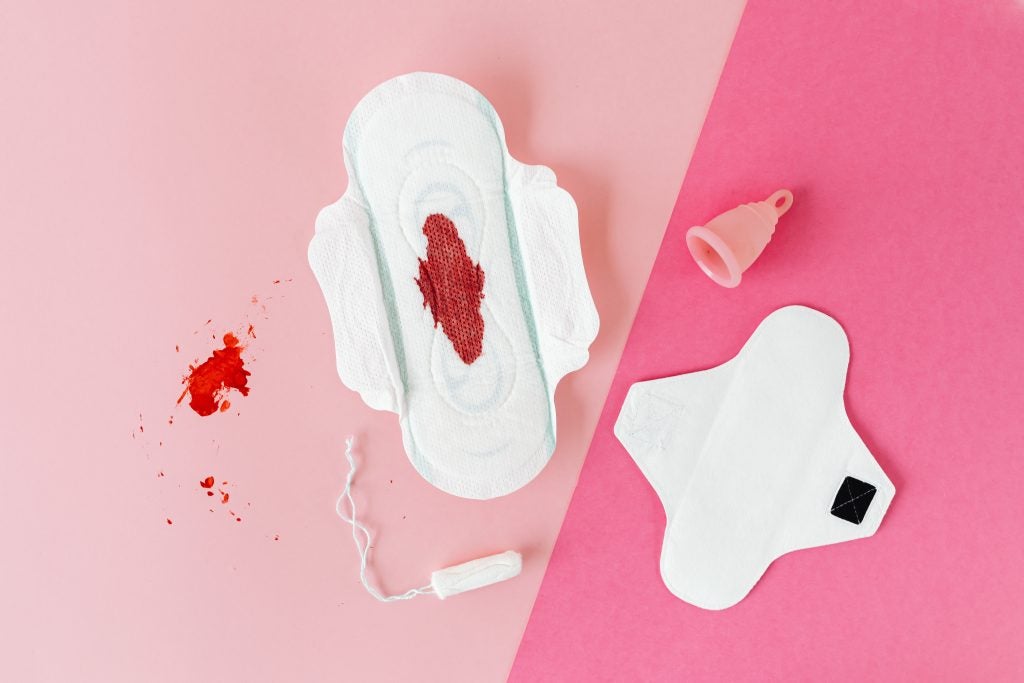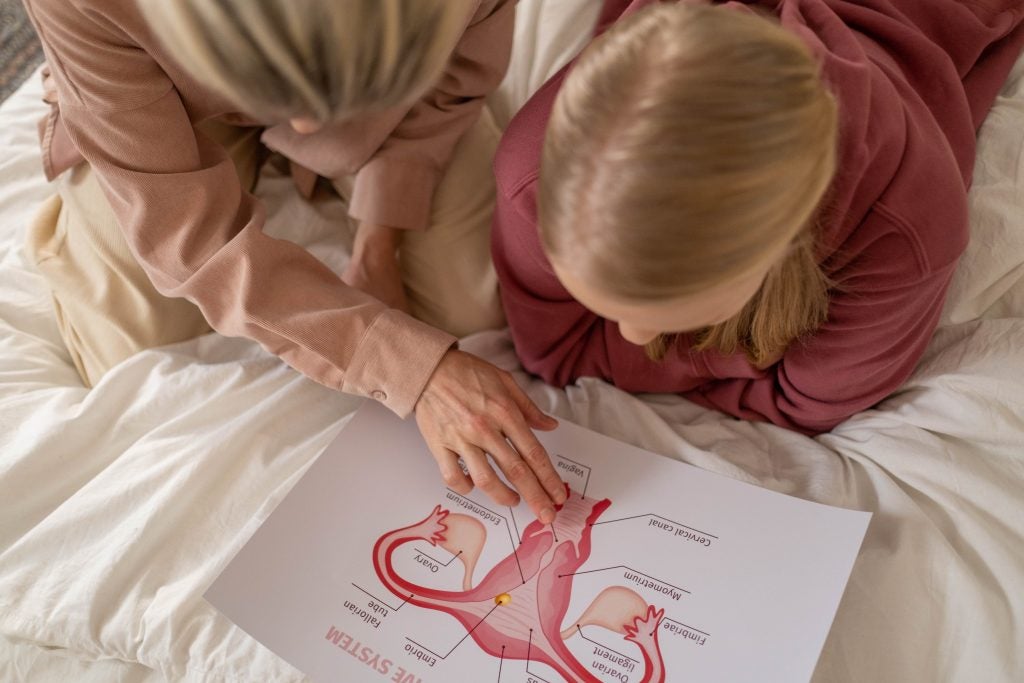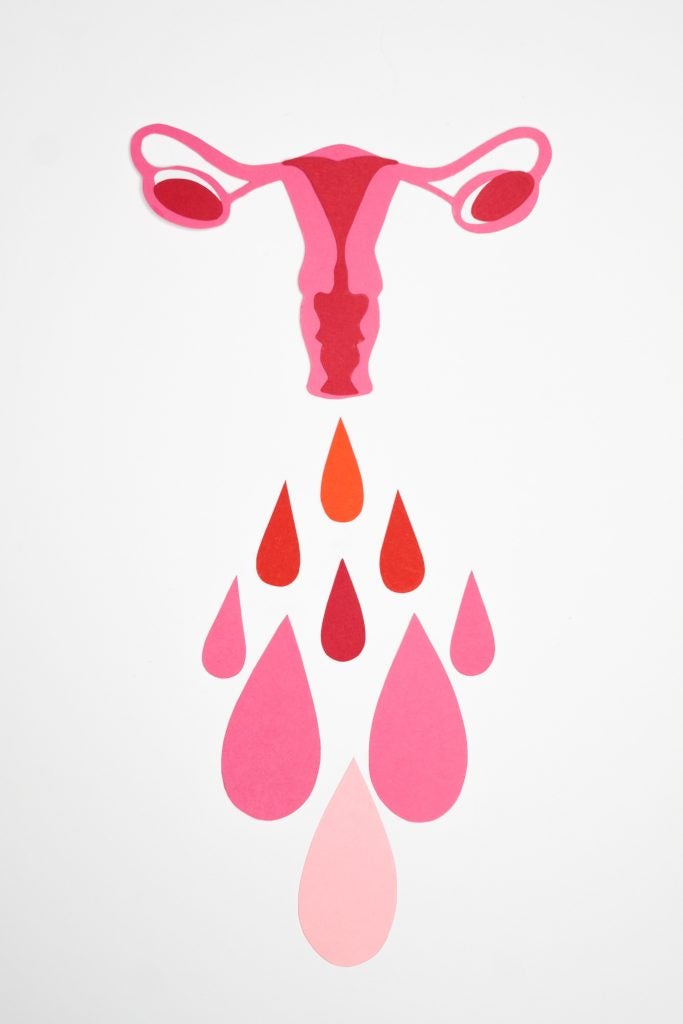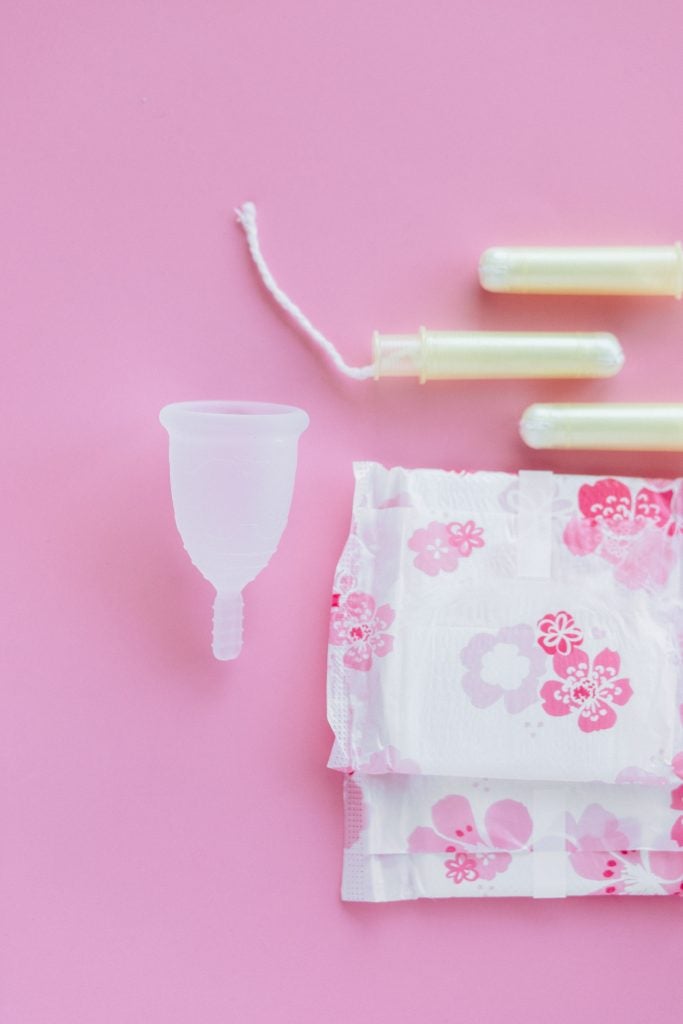
A girl’s first period is an important step in her life. It can be a very exciting time, but it can also be confusing and stressful. The best way to make the process more comfortable for your daughter is to try to educate and prepare her the best you can.
Table of Contents
What Is Menstruation
Menstruation, also known as a female’s period, is the discharge of blood from a female’s uterus through her vagina. The flow of blood can last anywhere between 3 to 7 days.2 An average menstrual cycle lasts between 28 and 30 days but can vary from 20 to 40 days.2 A female’s menstrual cycle may stabilize or it may fluctuate between cycles. The cycle length and the length of menstrual flow varies between females.
About once every twenty-eight days, the female body prepares the uterus in anticipation of a fertilized egg. At the onset of puberty, estrogen levels begin increasing in a female’s body. Estrogen is a hormone that causes the inner uterine lining (the endometrium) to begin building up tissue in preparation for implantation of the egg into the uterine wall. Progesterone levels, also increase in the body during puberty and causes one of the two ovaries to release an unfertilized egg into the fallopian tubes (a process called ovulation). Once the egg (ovum) reaches the uterus, it may or may not be fertilized by sperm. If the ovum is fertilized (thus becoming a zygote), the egg implants itself inside the uterine wall, the menstrual cycle is interrupted, and pregnancy begins. However, if the egg is not fertilized due to a lack of sperm in the female reproductive tract, the endometrial wall will begin to shed. This shedding of blood and built-up uterine tissue through the vaginal canal is what females experience as menstruation.
Click here if you want to read more about the phases of the menstrual cycle.
When to Talk

Start talking about menstruation to your daughter early and often. The onset of menstruation can vary with every woman so it is best to start the conversation early. Trying to explain everything about menstruation in one sitting can be overwhelming for a preteen, so it is best to break up the conversation into smaller, frequent conversations and spread them out as you feel appropriate.4 A preteen will likely feel more comfortable having smaller more casual conversations than one long private conversation.
If she begins asking you questions, always answer with honesty and comfort. If she has not asked you any questions, it is important that you initiate the conversation, because she most likely does have questions, but feels uncomfortable asking. You as a caregiver need to set the tone for the conversation. The more comfortable you appear to be, the more comfortable she will feel as well. For fathers, setting the tone of comfort is especially important because your daughter is likely to feel more uncomfortable talking about menstruation with a male than she would with a female. However, if you set the tone right and appear very comfortable yourself, she will feel comfortable as well.
You can begin by asking her what she already knows about puberty and menstruation. Kids learn a lot from their friends, both accurate and inaccurate information. It is important to clear up any misconceptions she may have and provide her with factual information. The way you phrase these questions can affect how comfortable she will feel about discussing menstruation at the time. Bringing up these types of questions around other people can sometimes make a preteen feel embarrassed. Older sisters or close family members, however, may help make the conversation more comfortable. It is also helpful to align your personal conversations with what she may be learning in school about puberty.4
What to Talk About
Ask her what she has learned in class or friends and follow up with more specific questions. This will help you get an idea of how well your daughter understands puberty and menstruation, and will allow you to clear up any confusions she may have. Providing accurate, factual information is very important. If you are a female, you can also talk about your own personal experiences during these conversations, such as when you learned about puberty in school and when your first period started. If you are a male you can bring up your own type of personal stories as well, such as when you first learned about menstruation and any misconceptions you may have had. If you grew up with sisters or had any girlfriends who talked to you about their periods, you can bring up those menstruation stories. As a father, sharing any knowledge you have about menstruation with your daughter will let her know that you do have an understanding of what she will go through and that she can go to you with questions and problems.
Explain what menstruation is in understandable and age-appropriate language. Begin with simple explanations, such as explaining that girls start getting their periods when they are able to get pregnant, but if they are not pregnant, blood comes out. Gradually give more detailed and physiological explanations with consecutive conversations and as she ages. Answer any questions she may have following your explanations.
You will also need to talk about menstrual products. If you are a female, you can talk about what products you use and why you like it but you should discuss all of the different kinds of menstrual products with your daughter so she knows what her options are. If you are a male, it is helpful to become familiar with the different kinds of menstrual products available.
You can also talk with women you may know about their personal preferences. It is helpful to buy some menstruation products ahead of time so your daughter can become familiar with them and have some available to her for when she gets her first period.4 The most common menstrual products used are menstrual pads, tampons, and menstrual cups. Menstrual pads are generally made of cotton and have an adhesive layer on the bottom to place on underwear. Tampons are cotton cylinders that are inserted into the vagina and removed by pulling a string that hangs from the tampon. Tampons should be changed every 4-6 hours and should never be left in for longer than 8 hours.7 Leaving a tampon in for more than 8 hours poses a risk for developing Toxic Shock Syndrome.7 Menstrual cups are reusable, cylindrical cups made of silicone or rubber that are inserted into the vagina to collect blood. Menstrual cups can remain inserted in the vagina for up to 12 hours and have no known connection to Toxic Shock Syndrome.7 You can read more about menstrual products here.
Helpful Tools
Sometimes we need more than just our knowledge to help educate others. Thankfully, there are some resources that can help you talk to your daughter about menstruation. Period books and puberty books written for young and teenage girls can be a helpful source of additional information.5 Period starter kits can also be a fun way to prepare your daughter for her period. These generally contain panty liners, pads, informational booklets, small calendars and a small pouch to carry around her period necessities. “Dot girl” and “Hello Flo” are popular period kits you can purchase online. You can also make your own period starter kit by including all the necessities, informational booklets or books, and any other treats you may want to include, such as her favorite candy. It is also fairly easy to find educational videos and tutorials online. Here are some examples of helpful videos:
Common Questions / Practical Advice
Girls generally have lots of questions about periods, beyond just the physiological aspects of it. They also want practical advice. Here are some common question she may have and some helpful tips.
When will I get my period?
Most girls get their first period between the ages of 11 and 13, but there they can get it as early as 8 years old or as late as 16 years old.3 Menstruation usually begins about 2 and a half years after the onset of breast development.5 Let your daughter know that everyone is different and she may get her period earlier or later than her friends or sisters. If your daughter reaches 15 years of age and still has not had her first period, it is a good idea to check in with her doctor.5 It is hypothesized that menstruation begins once the female has a certain amount of body fat.2 If your daughter has low body fat, this may be the reason she has not yet started her period. Many athletes with low body fat stop menstruating.2
How will I know I started my period?
Females cannot always feel the flow of blood coming out, but she may feel some dampness in her vaginal area and underwear, and may find some spots of blood on her underwear. She may also first notice a small amount of blood when she urinates. The presence of blood is the sign that she has started her period. The color of the blood can range from bright red to a darkish brown color.2
How long does it last?

The length of menstruation varies between females and even in a single female. It can range anywhere from 3 to 7 days.5 Your daughter’s first period is likely to be very light, with only a few drops of blood occurring.5 The amount of blood and length of her period can vary month to month.
Does it Hurt?
This is a common fear among girls, especially if they have heard other women complain about their period. Let her know that the flow of blood does not hurt and most of the time she will not even feel it coming out.6 There are some pains that may come along with having her period, such as abdominal cramps, muscle aches, and headaches.2 Some females experience all of these and some may not experience any. Let her know that it varies, and that there are ways to help alleviate any pain she may have. Pain killers and heated pads can help with cramps, as well as avoiding any food that she notices increases the pain of cramps.
See a doctor if over the counter medication does not alleviate your daughter’s menstruation cramps.4
When will I stop having my period?
A female generally reaches menopause, which is when a female’s menstrual cycle stops, between 40 and 55 years of age.2
Why don’t boys get periods?
Many girls ask this question, especially when they first get their period and do not fully understand the biological process. Explain to her that boys and girls develop differently during puberty. Males change in different ways, because they have a different anatomy and different levels of hormones than girls. Periods have to do with changes in the uterus, a body part that only females have.5
Will anyone know I’m on my period?
If she does not tell anyone, no one will know! If anyone asks her, it is up to her if she wants to let them know. The only people who may know are any other girls who are in the restroom and hear her opening a pad or tampon. Remind her that all girls get their period at some point and that she should not feel embarrassed about changing pads or tampons in a public restroom.
What do I do when I start my period?
Explain to your daughter that she’ll have to use some kind of menstrual product when she is on her period. Introduce her to different types of menstruation products. Most girls are more comfortable beginning with sanitary napkins,, but others may feel comfortable beginning with tampons. It is helpful to keep a stock of a variety of menstrual products in the bathroom ahead of time. This way she will have products on hand when she starts her period and she can try out a few different products to see what she is most comfortable with. Some menstruation products, such as tampons and menstrual cups can be a little difficult to use at first, so you should help explain to her how to use them. It is helpful to read the instructions that come in the box of menstrual product with her. Let her know that it is okay if she has difficulty the first few times and encourage her to practice. Assure her that she can go throughout her day as normal.6
How will I know when I will start my next period?

Explain to her that the average cycle lasts between 28 to 30 days, but this can vary a lot, especially within the first year.2 Encourage her to keep track of when her period begins and ends on a calendar. She can do this with a wall calendar, small personal calendar, or an electronic device’s calendar. It is also helpful to take notes of how heavy or light the flow is and any symptoms she experiences prior to and during her period. This will help her calculate her average cycle and period length and learn if any symptoms reliably predict that she is going to start her period soon. Free mobile and tablet applications are also available to her to keep track of her period and symptoms. After a few months of stored data, these apps can chart her average cycle and predict on what day she will get her next period. “Clue,” available for free on iOS and Android, includes these features along with educational information. Period Track Lite, also available for free on iOS and Android, has a less scientific approach, but has a very teenage friendly look.
Can I still play sports and go swimming?
Yes! Let her know she can do everything she normally does when she is on her period too. Although she can use pads while playing sports, many girls feel more comfortable using a tampon. It’s best to give her options and let her experiment with what she is most comfortable using. Although swimming can temporarily reduce the flow of blood, there is still chance of leakage.5 It is best to be prepared and use a tampon or menstrual cup while swimming to avoid leakage.1
What if I’m not at home?
Encourage your daughter to carry around a few pads or tampons, especially when her period becomes more regular and she is expecting to start soon. If she has a locker at school, advise her to store a few menstrual products there as well. If she starts her period at school, let her know that school nurses and female PE coaches usually keep a stock of pads and tampons for students. She can also ask her friends if they have any. Some public restrooms also have dispensable tampons for a small charge, usually about 25 cents. If she starts her period and does not have any menstrual products on her, she can make a temporary product of toilet paper by wrapping some around the middle of her underwear.
What if I stain my clothes?
Stains happen and that is okay! Tell her she can wrap a sweater or flannel around her waist to cover up the stain until she is able to change clothing. It is helpful to wear dark pants when she is on her period to make any accidental stains less noticeable. Remind her to visit the bathroom periodically to check if she needs to change her pad or tampon.
Be Positive and Welcoming
A girl’s first period can be stressful. She is likely to be confused and anxious. The best thing you can do is try to educate her the best you can and make the process more comfortable. Let her know you are there to help her in any way. Above all, let her know that her period is not something to dread. It is not a “curse,” but rather an important step in becoming a woman and it is something she can be happy about and look forward to!
If you have any more questions about menstruation or if you would like more tips for talking to your daughter about her period, please feel free to ask us, we are here to help!
References
- “Can You Swim On Your Period?” New Health Advisor. N.p., Apr. 2016. Web. 21 Apr. 2016.
- Greenberg, Jerrold S., Clint E. Bruess, and Sara B. Oswalt. “Sexual Response and Arousal.” Exploring the Dimensions of Human Sexuality. 5th ed. Sudbury, MA: Jones and Bartlett, 2013. 156-81. Print.
- “How to Explain Menstruation to Your Daughter.” Always. Procter & Gamble, n.d. Web. 21 Apr. 2016.
- Mayo Clinic Staff. “Menstruation: Preparing Your Preteen for Her Period.” Mayo Clinic. Mayo Foundation for Medical Education and Research, 30 Aug. 2014. Web. 21 Apr. 2016.
- “Talking to Your Child About Menstruation.” KidsHealth. The Nemours Foundation, Oct. 2014. Web. 21 Apr. 2016.
- “10 Common Period Questions.” Always. Procter & Gamble, n.d. Web. 21 Apr. 2016.
- “Menstrual Products.” SexInfo Online. 12 February 2013. Web. <http://www.soc.ucsb.edu/sexinfo/article/menstrual-products>
Last Updated: 2 June 2016
